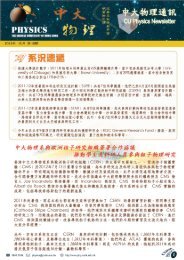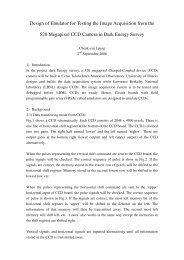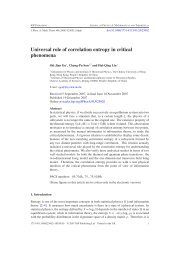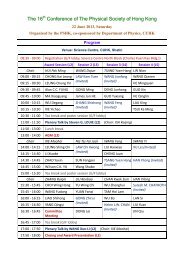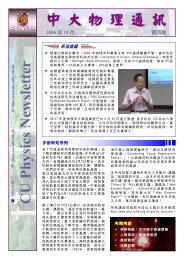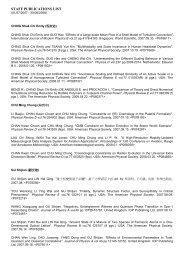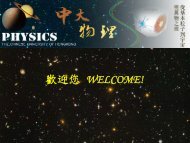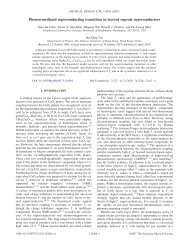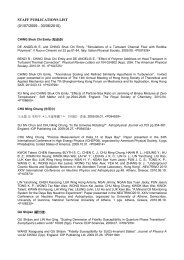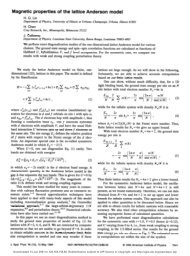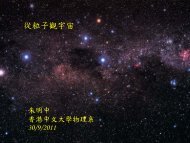Constructing soluble quantum spin models - Department of Physics ...
Constructing soluble quantum spin models - Department of Physics ...
Constructing soluble quantum spin models - Department of Physics ...
Create successful ePaper yourself
Turn your PDF publications into a flip-book with our unique Google optimized e-Paper software.
H.Y. Shik et al. / Nuclear <strong>Physics</strong> B 666 [FS] (2003) 337–360 349<br />
As a demonstration, we present derivations for the <strong>spin</strong>-1 case here. Obviously,<br />
expression <strong>of</strong> the Hamiltonian in terms <strong>of</strong> bond operators is even more complicated.<br />
However, since the main concern is about how H 3D Eq. (42) acts on the completely<br />
dimerized state ψ D , only terms consisting <strong>of</strong> singlet operator s need to be considered.<br />
Hence, one can simplify the expression <strong>of</strong> the bond operator representation by keeping the<br />
terms with singlet operator s only,<br />
√<br />
2<br />
S z =−S ′ z (<br />
→− t<br />
†<br />
3<br />
(44)<br />
and<br />
0 s + ) s† t 0 ,<br />
√<br />
2<br />
S + =−S ′+ (<br />
→ t<br />
†<br />
1<br />
(45)<br />
3<br />
s − ) s† t −1 ,<br />
(46)<br />
S i =−S ′ i .<br />
S i · S j ψ D = S ′ i · S′ j ψ D =−S i · S ′ j ψ D =−S ′ i · S j ψ D .<br />
Thus, the bond operator representation for the four <strong>spin</strong> interactions, (S i · S j , S ′ i · S′ j , S i ·<br />
S ′ j , S′ i · S j ) are now the same upto a sign. So we only need to consider one <strong>of</strong> them, say,<br />
S i · S j ,<br />
(47)<br />
S i · S j = Si z Sz j + 2( 1 S<br />
+<br />
i<br />
Sj − + ) S− i S+ j ,<br />
(48)<br />
when for i ≠ j<br />
S z i Sz j = 2 3<br />
( t<br />
†<br />
(49)<br />
0i t† 0j s is j + t † 0i s† j s it 0j + s † i t† 0j t 0is j + s † i s† j t )<br />
0it 0j ,<br />
S<br />
i + Sj − = 4 (<br />
−t<br />
†<br />
(50)<br />
3<br />
1i t† −1j s is j + t † 1i s† j s it 1j + s † i t† −1j t −1is j − s † i s† j t )<br />
−1it 1j .<br />
When i = j, some four-operator terms will reduce to two-operator terms, e.g., t † 1i t 0it † 1j t 0j →<br />
t † 1i t 1i(1 + t † 0i t 0i) → t † 1i t 1i. Thus, we have to keep terms with t operators but neglect terms<br />
with p operators, i.e.,<br />
S z i Sz i → 1 2 t† 1i t 1i + t † 0i t 0i + 1 2 t† −1i t −1i + 2 3 s† i s i,<br />
S + i<br />
S − i<br />
→ 2t † 1i t 1i + t † 0i t 0i + t † −1i t −1i + 4 3 s† i s i,<br />
S − i<br />
S + i<br />
→ t † 1i t 1i + t † 0i t 0i + 2t † −1i t −1i + 4 3 s† i s i,<br />
(51)<br />
(52)<br />
(53)<br />
To simplify the expression, let us denote O i;j as<br />
O i;j ≡ 2 3<br />
(<br />
t<br />
†<br />
0i t† 0j s is j + t † 0i s† j s it 0j + s † i t† 0j t 0is j + s † i s† j t 0it 0j<br />
− t † 1i t† −1j s is j + t † 1i s† j s it 1j + s † i t† −1j t −1is j − s † i s† j t −1it 1j<br />
− t † −1i t† 1j s is j + t † −1i s† j s it −1j + s † i t† 1j t 1is j − s † i s† j t 1it −1j<br />
)<br />
.<br />
(54)



